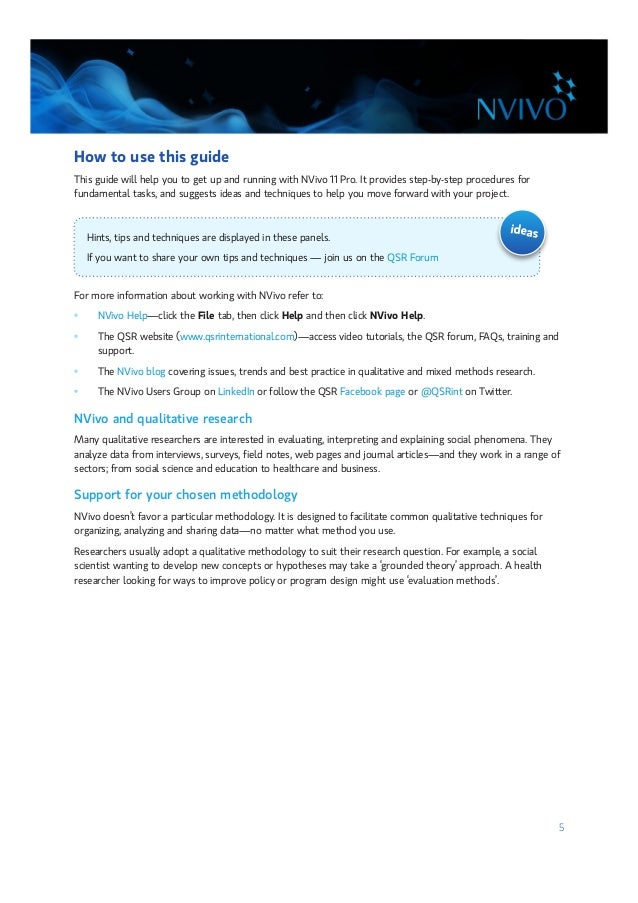May 11, 2016 Have a question about NVivo 11 for Windows? Remember to tag your post to indicate which edition you’re using. NVivo does not prescribe an approach but provides the tools to let you work the way that suits you best. For example, if you have large dataset sources—make the most of NVivo's auto coding feature. If you have a smaller number of sources that require close analysis—take advantage of the easy-to-use manual.
| Developer(s) | QSR International |
|---|---|
| Stable release | |
| Operating system | Microsoft Windows, macOS |
| Type | Qualitative data analysis |
| Website | www.qsrinternational.com/nvivo/ |
NVivo is a qualitative data analysis (QDA) computer software package produced by QSR International. It has been designed for qualitative researchers working with very rich text-based and/or multimedia information, where deep levels of analysis on small or large volumes of data are required.[1]
NVivo is used predominantly by academic, government, health and commercialresearchers across a diverse range of fields, including social sciences such as anthropology, psychology, communication, sociology, as well as fields such as forensics, tourism, criminology and marketing.
The first NVivo software product was developed by Tom Richards in 1999. Originally called NUD*IST, it contained tools for fine, detailed analysis and qualitative modeling.[2]
Description[edit]
NVivo is intended to help users organize and analyze non-numerical or unstructured data. The software allows users to classify, sort and arrange information; examine relationships in the data; and combine analysis with linking, shaping, searching and modeling.
The researcher or analyst can test theories, identify trends and cross-examine information in a multitude of ways using its search engine and query functions. They can make observations in the software and build a body of evidence to support their case or project.[3]
NVivo accommodates a wide range of research methods, including network and organizational analysis, action or evidence-based research, discourse analysis, grounded theory, conversation analysis, ethnography, literature reviews, phenomenology, mixed methods research and the Framework methodology.[4] NVivo supports data formats such as audio files, videos, digital photos, Word, PDF, spreadsheets, rich text, plain text and web and social media data.[5] Users can interchange data with applications like Microsoft Excel, Microsoft Word, IBM SPSS Statistics, EndNote, Microsoft OneNote, SurveyMonkey and Evernote; and order transcripts from within NVivo projects, using TranscribeMe.[6]

NVivo is available with English, French, German, Portuguese, Spanish and Simplified Chinese interfaces. A separate Japanese version is also available.[7]
Version history[edit]
Nvivo 11 For Mac Manual Download
Note: software named NVivo from 1981 to 1997.
- N4 – 1997
- N5 – 2000
- N6 – 2002
- NVivo 2 – 2002
- NVivo 7 – 2006 (consolidation of NVivo and N6 (NUD*IST))
- NVivo 8 – 2008
- NVivo 9 and NVivo for Teams – 2010
- NVivo 10 – 2012
- NVivo for Mac Beta – 2014
- NVivo for Mac commercial release – 2014
- NVivo 11 for Windows in three editions; NVivo Starter, NVivo Pro, NVivo Plus. Updates to NVivo for Mac and NVivo for Teams – 2015
- NVivo 12 (Pro, Plus, Mac, and Teams) – 2018
See also[edit]
References[edit]
- ^McNiff, Kath (November 9, 2016). 'What is Qualitative Research?'. The NVivo Blog. QSR International. Retrieved March 12, 2017.
- ^Tom and Lyn Richards (2003), 'The way ahead in qualitative research', Journal of Modern Applied Statistical Methods, Vol.2, Issue 1, https://digitalcommons.wayne.edu/jmasm/vol2/iss1/4/
- ^Karen Dearne, Australian IT (July 2008) 'Not easy being green, but audits help' Retrieved on 28-11-2008.
- ^Strategic partnership delivers greater flexibility to qualitative researchers in the UK and around the world, National Centre for Social Research, Retrieved 17-10-2011.
- ^About NVivo 10Archived 2011-11-11 at the Wayback Machine, Retrieved 16-07-2012.
- ^NVivo and TranscribeMe
- ^NVivo 10 Software for Unstructured Data Analysis Now Available in Six New Languages, Retrieved 26-02-2013